Introduction and Overview
This is the sixth edition of the ECS Strategic Research and Innovation Agenda (ECS-SRIA), jointly developed by the experts of the ECS community, coordinated by the three industry associations: AENEAS, Inside Industry Association (formerly ARTEMIS-IA) and EPOSS. This revision of the ECS-SRIA 2022 was conducted with the goal to further improve the delineation of the concepts introduced in 2021/22, the alignment and the synergies between Chapters. Especially, in the Foundational Chapters, Chapter 1.1 (Process technology, equipment, materials & manufacturing) has extended the technology details in Major Challenges 1 and 3, and extended the focus on sustainable manufacturing in major challenge 4. Chapter 1.2 (Components, modules & systems integration) has been re-structured to rationalise/simplify the major challenges and the topic of integrated silicon photonics has been introduced. In Chapter 1.3 (Embedded software and beyond) the topics of parallelization, Open Source, integrability, and ES support for heterogeneous accelerators have been strengthen. In Chapter 1.4 (System of Systems) Major Challenge 4 has been extended to SoS integration along the lifecycle including all the phases of the lifecycle. Regarding Cross Sectional Chapters, in Chapter 2.1 (Edge computing & embedded AI) we introduced new technological challenges: new models and architectures to support neural network in the embedded space, automatic adaptation solutions of complex neural networks to embedded systems and certifiable AI. Chapter 2.2 (Connectivity) has been aligned with SNS JU about 6G and a major challenge about 6G & networking virtualisation for SoS has been introduced. In Chapter 2.3 (Architecture and design: methods and tools), the topics of virtual verification & validation and of verification and validation of AI-based systems have been introduced. Regarding the Application Chapters, in Chapter 3.1 (Mobility) the focus on climate change and carbon neutrality has been strengthened and the concepts of open-source HW for Mobility, CarOS and software defined vehicle have been introduced. Chapter 3.3 (Digital Industry) has been subject to a global refresh, including new links to open source HW, AI and energy. In Chapter 3.4 (Health and wellbeing) the market figures have been updated and an alignment with IHI JU has been introduced. Chapter 3.5 (Agrifood and natural resources) strengthened the focus on climate change, block chain and data fusion, and introduced the topic of agriculture as a service. Chapter 4 (Long Term Vision), has been reviewed to reflect the updates introduced in each Chapter of the ECS-SRIA 2023. Since last release, a single-diagram outline of the ECS-SRIA has been included, to clarify the roles of the Chapters, the technology domains they cover and the synergies between them, simplifying the comprehension of the ECS-SRIA and its “navigation”. Finally, the report about “Open Source Hardware and RISC-V”1, which defines a strategy and roadmap for RISC-V and Open Source hardware in different application domains strategic for Europe, has been included in the ECS-SRIA 2023 as a separate appendix: these topics will be further integrated in future versions of the ECS-SRIA.
Why this ECS-SRIA?
This document describes the Major Challenges, and the necessary R&D&I efforts to tackle them, in micro- and nanoelectronics for smart systems integration all the way up to embedded and cyber physical systems, and System of Systems.This SRIA is intended to be funding programme agnostic and can be used as a basis for the various cooperative programmes across Europe.
However, the scope of our work, and of this document, is firmly within the ECS domain. For details on developments in the specific application areas further up the value chain, please consult the SRIAs of other associations or public/private partnerships (PPPs) addressing those specific areas.
The range of this ECS-SRIA is very wide, going from transistors within silicon chips acting as individual electrical switches for integration in smart systems up to global System of Systems performing complex cognitive tasks and interacting with numerous humans and machines over a wide geographical spread. A very simplified view of this ECS technology “stack” is illustrated in Figure F.1 with an example.
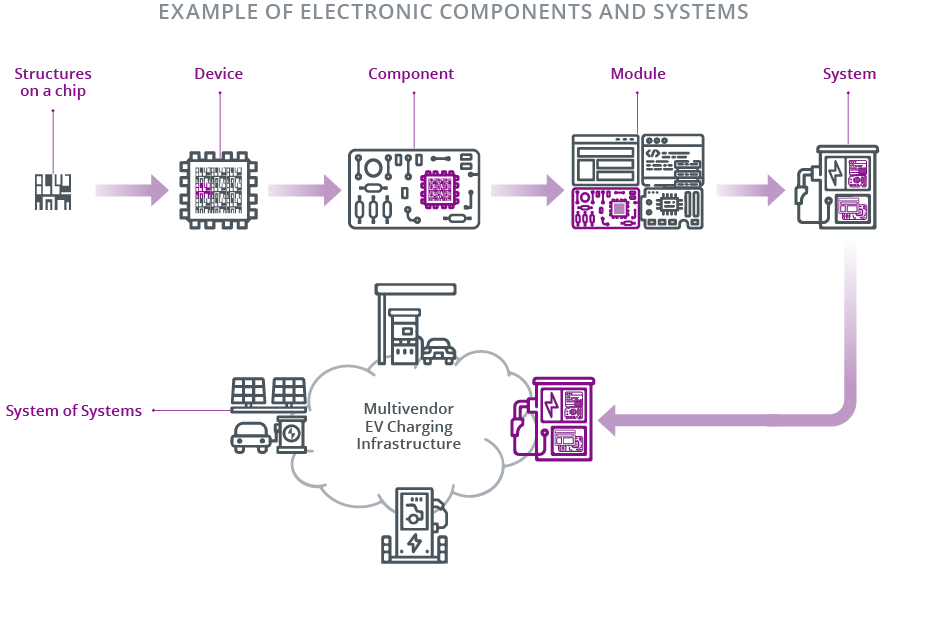
Designing such artefacts requires an interdisciplinary hierarchical approach, whereby various ECS specialists are working at different abstraction levels. As a result, the same term can have different meanings for specialists of different ECS domains: for instance, a “system” designed and implemented within a given development process may be integrated as a “component” into a higher-level “system” within another development step of the engineering process. Nevertheless, to avoid confusion, since 2021 the ECS-SRIA includes a glossary, to be found in Annex page 587, where many of the key terms are defined to avoid inconsistency across the various Chapters. It was also felt that developing a common language was important in building a strong and integrated ECS community. In addition, some of the bricks of the ECS technology “stack” are further detailed below.
- Device: in the context of the ECS-SRIA, and if it is not further qualified, a device will be defined as a “packaged chip”, whether it is a packaged integrated circuit (e.g. system on a chip, memory, processor, microcontroller) or a micro-electromechanical system (MEMS)/micro- opto-electro-mechanical system (MOEMS). A device performs a general electrical, electronic or electrical/electronic/physical transduction role.
- Component: a combination of devices and other elements (such as passives) that fulfil a specific need, such as transduction of a single physical parameter within a well-specified case. A component is not self-contained in all its functions, as it requires the close support of other components for operation (e.g. in data processing, power handling, embedded software).
- Module: a combination of correctly integrated components in which their assembly embodies a specific functionality required for the proper working of a system (e.g. sensing and actuation module, control module, communication module, energy provision module). A module is self-contained in hardware and software, making it interchangeable between systems, and allowing a higher abstraction level in systems design.
- System: for the purpose of this SRIA, a system is a set of electronic-based constituents (subsystems, modules and components, realised in hardware, software, or both) that are integrated in a way that allows the system to perform a desired (set of) function(s). Due to ECS typically being constructed hierarchically, a “module” (e.g. camera or other sensor) being part of the electronic “system” in an autonomous car might itself be referred to as a “system” when being designed (e.g. while integrating lower-level components together to achieve the “camera” function).
- System of Systems (SoS): a collection of independent and distributed embedded and cyber-physical systems dynamically composed to generate a new and more complex system, provided with new functionalities and driven by new goals not present in the constituent embedded and cyber-physical systems individually. The difference between a “system” (comprising subsystems, modules and components) and a “System of Systems” (also comprising subsystems) is that the subsystems of a system are chosen and integrated during design-time (i.e. completely under the control of the engineers), while in a System of Systems the constituent (sub)systems are physically independent and dynamically form a System of Systems at run-time.
The structure
The first part of the ECS-SRIA is composed of four chapters focused on the Foundational Technology Layers and their technical challenges along the technology stack, from materials and process technology to components, modules and their integration into electronic systems, embedded software developments and software technologies, to full systems and Systems of Systems. These foundational layers are characterised by hierarchical dependencies due to the inherent nature of ECS and the way they compose and integrate in complex structures. Advances in all Foundational Technology Layers will be essential to creating new electronic chips, components, modules, systems, and systems of systems along the value chain: these are the fundamental elements required to build the digitalisation solutions of the future.
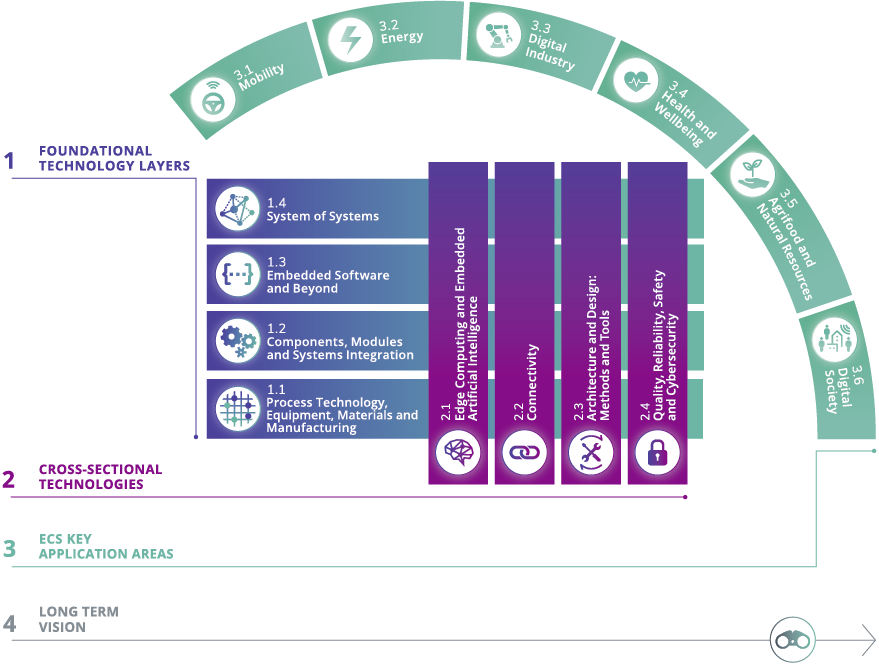
The foundational layers represent a very fertile ground where new interdisciplinary technologies, products and solutions can grow. They are then complemented in the second part of the ECS-SRIA by four Cross-Sectional Technology chapters that focus on transversal areas of scientific research and engineering, where innovative results emerge from the joint contribution of the foundational layers to those specific areas. Edge Computing and Embedded Artificial Intelligence, or Connectivity (e.g. 5G to 6G) will require new integrated circuits to develop innovative electronic components that can be used to develop smarter and more connected components, modules and entire systems, running smart software that will offer new functionalities and capabilities. That will allow these systems to interact, cooperate and merge in larger systems of systems. Similarly, Architectures and Design: Methods and Tools have to be further developed to provide support to each of the foundational layers, covering all domains along the technology stack, across the entire lifecycle of technologies and products. The same applies to Quality, Reliability, Safety and Cybersecurity concepts that can only be addressed successfully if they are encompassing the whole ECS process flow along the entire value chain.
The innovation generated by these cross-sectional technologies will be applied across foundational layer stacks and amplify the effect of innovation in all key ECS application domains. Of course, there is some overlap among the eight technology chapters since they are closely linked, but as they examine the individual challenges from different perspectives, this overlap is extremely constructive and generate valuable synergies.
In the third part of the ECS-SRIA, six Application Chapters describe the challenges arising from specific ECS application domains that are key for Europe and identify the R&D&I efforts required by these application domains as regards ECS.
Finally, the Long-Term Vision Chapter illustrates our vision of the ECS beyond the time horizon covered by the other chapters. It seeks to identify the research subjects that must be addressed at low TRL levels as foundation and preparation for the crucial developments in European industry over the next decade. Based on the trends and plans described in the preceding chapters, the long-term industrial requirements are also examined to help research programmes understand which hardware, software and system solutions should be produced most effectively for the continuous improvement of European digital technology.
As mentioned, the ECS covered by this document is very wide-ranging, and involves many technical disciplines in materials, processes, hardware and software. This means not many will understand all the technical details presented in the ECS-SRIA, and most readers will only want to read those chapters that cover the disciplines they are working in.
The structure of all the Foundational Technology and Cross-Sectional chapters is identical. This forms the basis for the authors to explore each application area from a different perspective, with the intention here being that the application demands are the main focus, not the technical challenges.
A Glossary describing the terms used in the document, as well as a List of Acronyms used in the document, can be found in the Appendix. An Analytical Index contains the key concepts covered in the ECS-SRIA and simplifies the “navigation” of the document. At the end, the reader can also find a List of Contributors who collectively wrote this ECS-SRIA.
Finally, to highlight the synergies/links between the chapters and provide hints to the reader, cross-references and hyrperlinks have been introduced.
Cross-references consist of the Chapter icon and appear alongside the text. When hovered on, they indicate the relevant chapter number and the topic or concept described in the text is also highlighted. When clicked on, they will navigate you to the referenced Chapter.
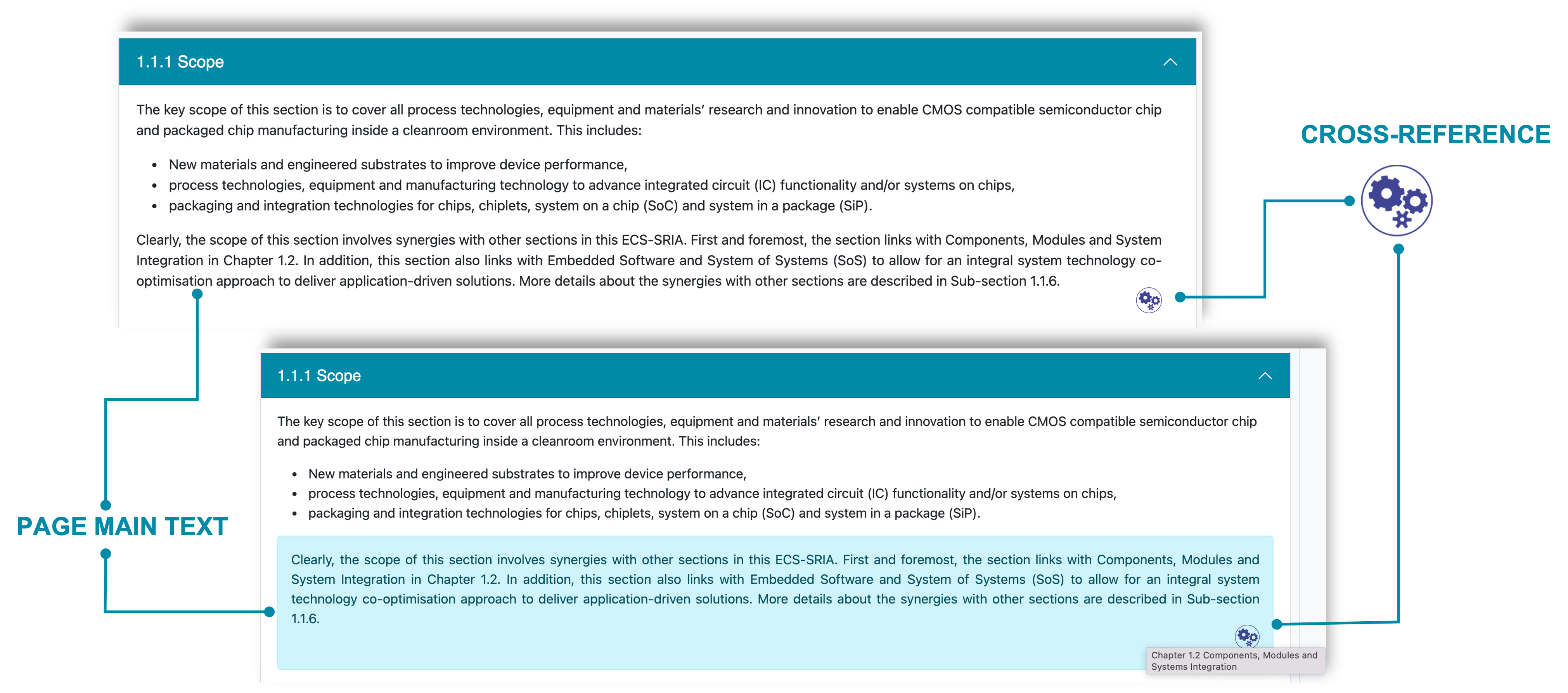
References within a text are indicated by small numerical markers embedded in the content, eg. 0, Upon clicking one of these markers, readers are instantly directed to the corresponding entry within the References section. This feature allows readers to seamlessly access the sources from which the information has been derived.
Furthermore, by clicking on the same footnote number located in the References section, readers can effortlessly return to the exact point within the main text where the reference was initially cited. This interactive function not only enhances the reader's comprehension but also streamlines the process of verifying and exploring the sources behind the presented information.
In this ECS-SRIA, the Major Challenges identified by the different Chapter teams were analysed and merged into four Main Common Objectives for the ECS community. In addition, three common Roadmaps covering the short term (up to 2027), medium term (until 2032) and the long term (2033 and beyond) provide the key milestones derived by the Chapter teams.
Main Common Objectives
For each technology and application domain, the ECS-SRIA identifies specific challenges, with a focus on the most critical aspects to be tackled from the perspective of innovation. The analysis of each challenge illustrates the state of the art of the associated technology and/or application domains, describes the vision of the ECS community for the future, identifies potential outcomes, defines research and engineering activities on the key focus areas that are fundamental to successfully addressing the challenge.
Across this document, 67 different Major Challenges are identified that have emerged from the analysis of the foundational technologies, the cross-sectional technologies and the application key areas. The Major Challenges are frequently interdependent – they influence each other, become increasingly demanding, and impact on many areas, including technology innovation, industrial competitiveness, security, safety, business and environmental sustainability, society, etc. From this perspective, the Major Challenges represent key factors for the achievement of the four Main Common Objectives, which are aligned with the European Commission’s strategic priorities (see table in Appendix, page 624).
Main Common Objective 1: boost industrial competitiveness through interdisciplinary technology innovations
Electronic components and systems, by their inherent nature, are the result of interdisciplinary research and engineering. This require competencies in diverse technology domains, including process technology, equipment, materials and manufacturing, electronics, and telecommunications, as well as cross-sectional technologies such as edge computing, artificial intelligence, high-speed connectivity, and cybersecurity.
ECS technologies are turning each digital good and equipment into an intelligent cyber-physical system, thereby driving new market demand. Embedded platforms for automotive (electric mobility, autonomous driving, etc.), industrial (Industry 4.0, IoT for agriculture, etc.), medical (medtech for connected patients, etc.), energy (new energy-aware ECS and more flexible energy management, etc.) will rely extensively and increasingly on ECS technologies.
These trends compel ECS research to be interdisciplinary to benefit from the multiple available sources of innovation, as well as to be research-intensive and market-oriented. This will ensure forthcoming ECS innovations will be of strategic value for Europe and boost its industrial competitiveness in all its value chains, and help building the strong industrial base essential for European strategic autonomy.
Main Common Objective 2: ensure EU digital autonomy through secure, safe and reliable ECS supporting key European application domains
A strong, competitive and sovereign ECS industrial and technological base will help Europe to:
- Fulfil its own digital technology needs in a way that reflects its interests and values.
- Improve the resilience of its critical infrastructure and ICT systems.
- Develop its ability to shape international rules, norms and standards.
European strategic autonomy will rely on a trustworthy and virtuous cycle by supporting the development of innovative ECS technologies focused on security, safety, reliability, dependability and privacy.
They will simplify the implementation of the European Strategy for Data3, 4, and ensure security, privacy-by-design and strategic autonomy all along the industrial and digital value chains. Such technological innovation will also enable the design and development of secure, safe, reliable, dependable, privacy-compliant electronic components and systems, as well as generate new requirements that will drive the development of new technologies, restarting the cycle.
Threats to Europe’s strategic autonomy are to be found in the microelectronics value chain, and downstream in the component user segments of the electronics industry. In this context, the Major Challenges identified by the ECS-SRIA will help develop innovations in secure, safe and reliable ECS technologies for creating EU-based/ made solutions in the key European applications domains of:
- Aerospace, defence, security.
- Automotive, transportation.
- Machinery, robotics, electrical equipment, energy.
- Communications, computing.
- Healthcare and well-being, etc.
European technology-based, secure, safe and reliable ECS, combined with European AI solutions, are critical to securing global leadership and strategic autonomy in key areas such as ICT and to ensure compatibility with EU values.
Main Common Objective 3: establish and strengthen sustainable and resilient ECS value chains supporting the Green Deal
European strategic autonomy will also require the sustainability and resilience of the entire ECS value chain since the development of innovative technologies focused on sustainability and the Green Deal will support ambitions to achieve a green, resilient and competitive Europe.
Moreover, the serious effects of climate change that we are experiencing daily and the current geo-political situation, which highlights our dependency from energy, further reinforce the need for Europe to accelerate its transition to climate neutrality by 2050.
This challenge must be perceived as an opportunity to create a new environment for boosting innovative aspects of technology and business models through achieving the following:
- Relying extensively on ECS-based technologies and digitalisation as key factors for lowering our global energy footprint at all the levels of the economy, and by placing sustainability at the heart of combined digital and green transitions.
- Positioning the European players in hardware as front-runners in sustainability to secure a wider market so they can become world leaders. This will need to consider the circular economy, new market positioning (by turning small market shares into specialisation areas), the environmental impact of global manufacturing, etc.
- Establishing this carbon-neutrality challenge based on a close link between the digital and green transitions at the core of future funded collaborative research and innovation in ECS. This will help ensure a positive impact for each stage of the value chain, and to achieve carbon neutrality right down to the final application/digital service.
This new context is required to fight and reduce the effects of climate change.
Main Common Objective 4: unleash the full potential of intelligent and autonomous ECS-based systems for the European digital era
ECS must be provided with intelligence and autonomy to control their complexity more efficiently and more cost-effectively. This will help provide novel advanced functionalities and services, limit human presence to only where it is strictly required, improve the efficiency of vertical applications, etc. Intelligence and autonomy are also required by the role of ECS in the application domains, representing an important factor for the sustainability and resilience of the value chains: an ECS-based system that provides intelligent energy management, relying on technologies such as AI, represents a key building block – for example, for smart home and energy applications. However, it also improves the resilience required to ensure optimal energy consumption in critical conditions and contributes to the sustainability of the value chain associated with vertical applications, since it reduces operational costs, environmental impact, improves the quality of service (QoS), return on investment (ROI), etc. thereby strengthening the global competitiveness of European companies and helping to achieve the objectives of the EU’s Green Deal.
Ensure engineering support across the entire lifecycle of complex ECS-based systems
As discussed, modern digitalisation systems are complex, and heterogeneous solutions are increasingly based on ECS. Therefore, they cannot be considered as real products without the appropriate engineering support across the entire lifecycle, from requirements analysis to design, development, deployment/commissioning, operation/management, remote-maintenance repair and overhaul, retirement/recycling and evolution.
Engineering support represents a key factor for achieving the four Main Objectives as it:
- Impacts industrial competitiveness by simplifying lifecycle management, and improves the quality of the engineering process, making it more cost-effective and agile.
- Simplifies and improves the development of trustworthy ECS technologies, products and applications.
- Supports sustainability and resilience that reduce lifecycle management costs, as well as ensuring the automation and continuity of operations.
- Is fundamental to unleashing the full potential of intelligent and autonomous ECS, which requires completely new approaches to engineering, design and development methodologies, as well as toolchains and tools.
- Improves professional training and education by strengthening and developing new and specific skills.
The ECS-SRIA 2023 lists a number of milestones to be reached in the short term (2023-2027), medium term (2028-2032) and long term (2033 and beyond) via collaborative research projects across Europe, reflecting the ambition of the ECS industry towards the achievement of the four Main Objectives identified above. The diagrams (pages 24-26) position some of the most salient of these milestones onto the European ECS roadmap.
The following figures summarise the main milestones to be reached in the various domains covered by the ECS-SRIA over the three time periods:
- Short term (2023-2027)
The industry has a precise idea of what will be achieved during this short-term timeframe. - Medium term (2028–2032)
There is still reasonably good knowledge of what can possibly be achieved. - Long term (2033 and beyond)
Expected achievements are more of a prospective nature.
Including a milestone in each of these time periods means that the described features are expected to be available at TRL levels 8–9 (prototype or early commercialisation) within that timeframe. For example, the Components, Modules and Systems Integration Chapter expects that, within the next five years (short term), the materials that enable recycling and repair will be available. These materials will allow for the deployment of the monitoring of forests, fields and oceans, as envisioned by the Agrifood and Natural Resources Chapter over the same time horizon. In parallel, this monitoring will gain in efficiency due to the development of advanced AI edge solutions leveraging open source or alternative strategies, as forecast by the Chapter on Edge Computing and Embedded Artificial Intelligence.
The above example also clearly shows that progress in the various domains covered by the ECS-SRIA are deeply interconnected. Innovation in one area is building upon, or being driven by, innovation in other areas. Similar examples could, of course, be developed for the other time horizons, as represented in the Figure F.3, Figure F.4 and Figure F.5.
More detailed diagrams, including additional milestones, are presented in the individual chapters.
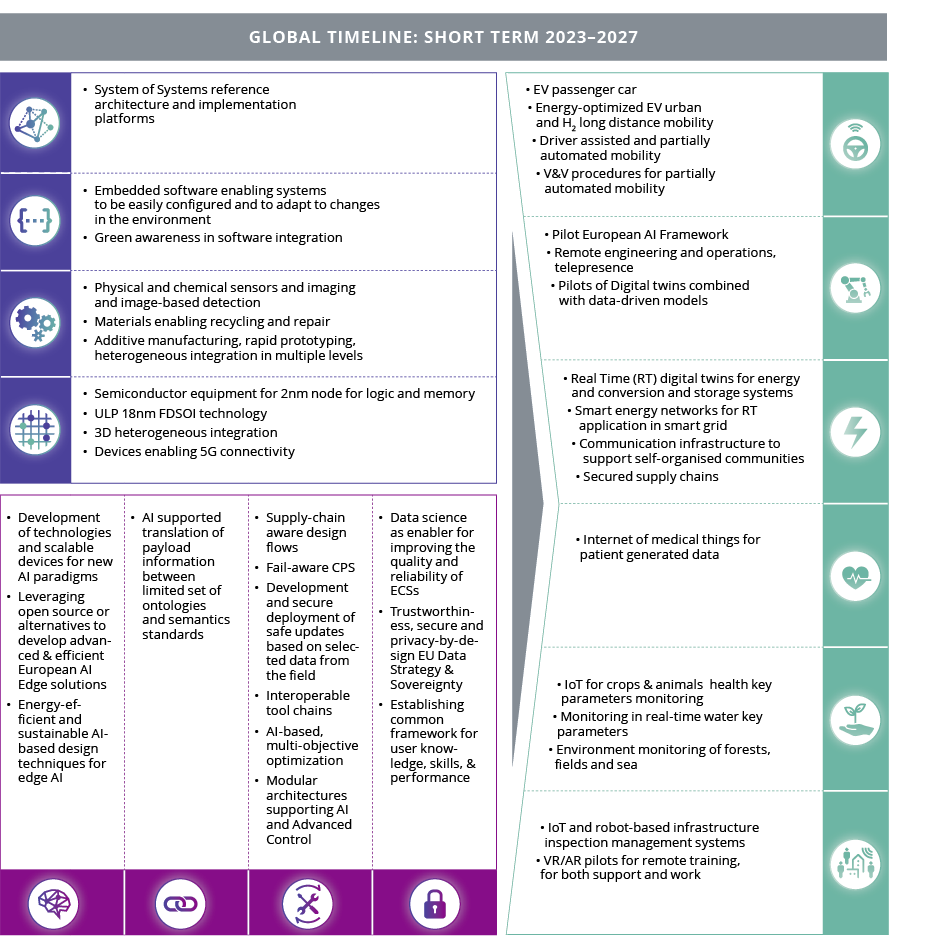
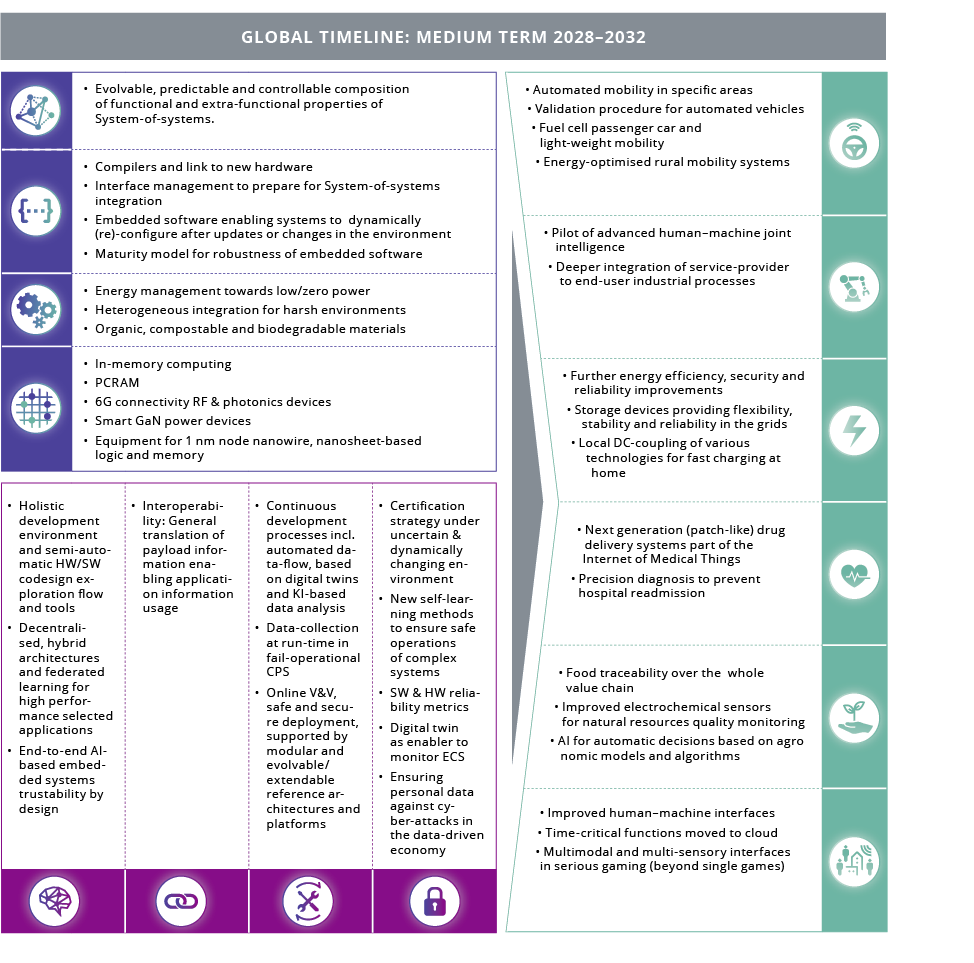
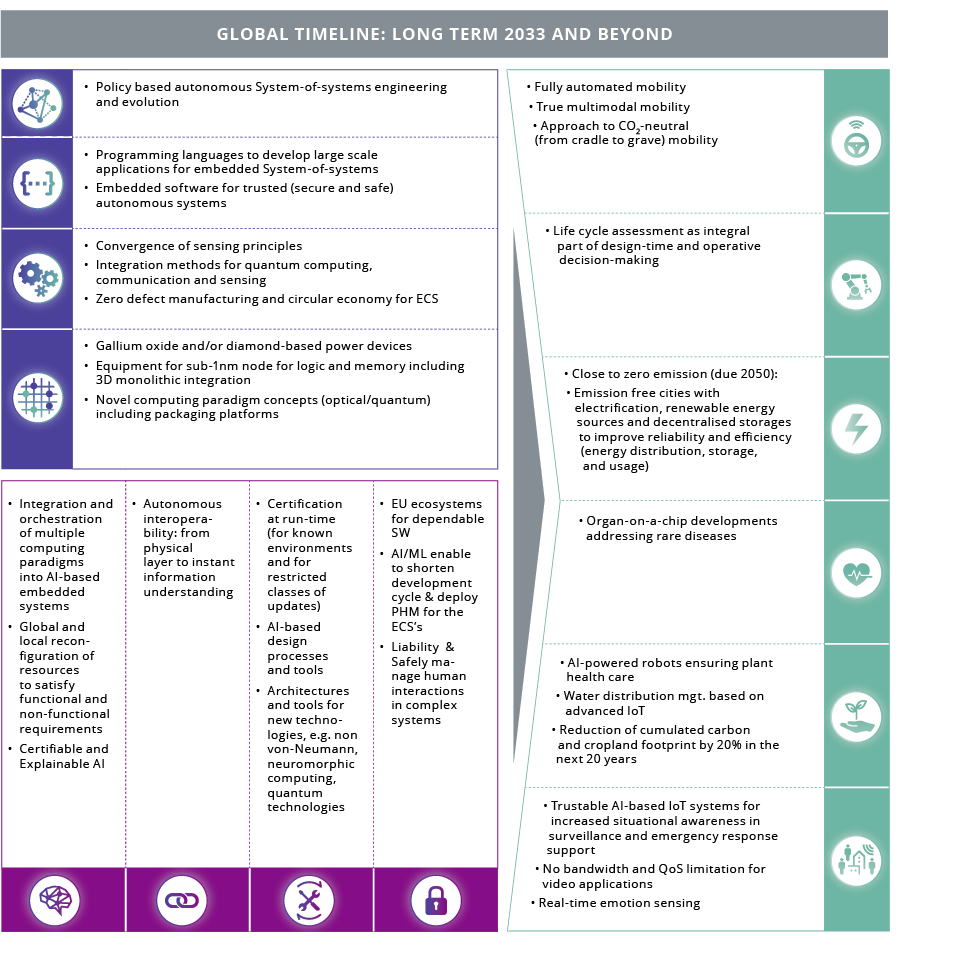
Electronics components and systems are key digital technologies enabling the development of numerous applications. As such, the ECS research and innovation priorities are significantly driven by application roadmaps and needs. To that effect, the Key Application Areas part of the ECS-SRIA translates application roadmaps into requirements for ECS. Conversely, the Foundational Technology Layers part maps out future advances and potential new breakthroughs in applications. The ECS-SRIA therefore promotes synergies with many neighbouring application-oriented communities. For example, the Mobility Chapter (Chapter 3.1) has strong links with ERTRAC; the Digital Industry Chapter (Chapter 3.3) with EFFRA; and the Agrifood and Natural Resources Chapter (Chapter 3.5) with the working group of the Alliance for the Internet of Things Innovation (AIOTI) in Smart Farming and Food Security, and with Water Europe5. In each case, experts participated in the work of both groups. There are also close interactions and alignments with European PPP initiatives such as 2Zero and CCAM, IHI, etc.
The Cross-Sectional Technologies part also leverages the links of the ECS community with other technology-oriented domains, such as the European Technology Platform for High Performance Computing (ETP4HPC), EuroHPC and Big Data Value Association (BDVA), with strong relations with the Edge Computing and Embedded Artificial Intelligence Chapter (Chapter 2.1). Likewise, the Connectivity Chapter (Chapter 2.2) benefited from fruitful exchanges with the 5G Infrastructure Association, SNS and inputs from the European Cyber Security Organisation (ECSO) are reflected in Chapter 2.4.
Several contributors of the Technology parts are also actively involved in the elaboration of international roadmaps (e.g. the Heterogeneous Integration Roadmap (HIR)6 in electronic packaging and integration, and the IEEE International Roadmap for Devices and Systems (IRDS)7 for the semiconductor industry).
To summarise, this ECS-SRIA combines application-pull and technology-push with the objective of enhancing the fertile dialogue between technologists and technology users, and strives to include discussions of upcoming strategic value chains.
0 Furthermore, by clicking on the same footnote number located in the References section, readers can effortlessly return to the exact point within the main text where the reference was initially cited.
1 https://digital-strategy.ec.europa.eu/en/library/recommendations-and-roadmap-european-sovereignty-open-source-hardware-software-and-risc-v
2 Structure on a chip: elementary building blocks of an integrated circuit, such as a FDSOI or FinFET transistor, or more complex structures such as an embedded memory block.
3 https://ec.europa.eu/digital-single-market/en/policies/building-european-data-economy

